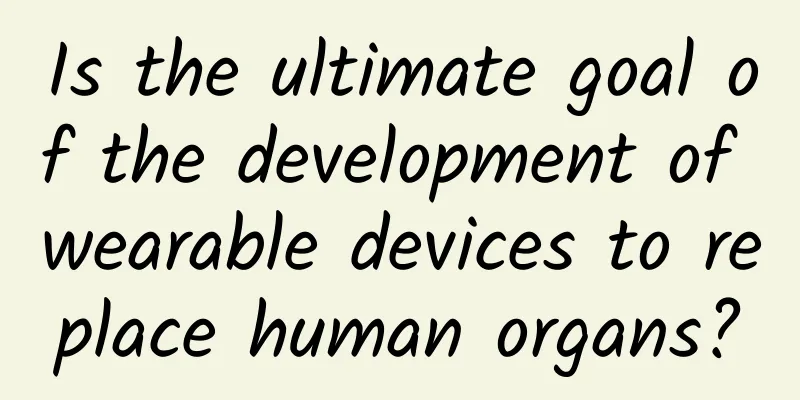Is the ultimate goal of the development of wearable devices to replace human organs?

|
Although wearable devices have experienced many years of development, they are still controversial. However, this controversy is an inevitable phenomenon in the development of new industries, especially for disruptive industries such as wearable devices, most people do not have a clear understanding of them. The current limited understanding is basically based on the most basic products such as smart glasses, smart watches, and smart bracelets. Obviously, this understanding cannot represent real wearable devices. Wearable devices are still in the early stages of development, that is, monitoring some basic life characteristics. Strictly speaking, wearable devices can be divided into four stages:
From the perspective of the entire wearable device industry, it is still at the initial stage, that is, the exploration of the digitization of human body characteristics. It can be predicted that in the coming 2016, the focus of the entire wearable device industry will still be on the digitization of human body characteristics. Whether it is the technical level of the industry chain or the industry talents, it is determined that this stage will take some time to develop. And this stage will have a long period of exploration and application process, the most typical of which is the gradual maturity of wearable medical products, which will, to a certain extent, promote the reconstruction of the entire medical technology and model. Similarly, it does not mean that wearable devices have lost their value in the first stage. On the contrary, the value of this stage is very huge. On the one hand, the digitization of human body characteristics is the basis for all subsequent stages, including the value of the Internet of Things, which is also released based on this precondition; on the other hand, the digitization of human body characteristics truly realizes the purpose of science and technology serving mankind. Obviously, this stage and process are the most challenging. It is a creation process from 0 to 1, including industrial chain technology, big data standards, etc. Because this stage is difficult, we have seen that after several years of development, the wearable devices on the market have shown a certain degree of convergence. From the perspective of product form, they are mainly wearable devices outside the body, mainly smart watches, bracelets, glasses, etc. From a technical perspective, they are basically centered around sports and some relatively basic life and health indicator monitoring. If we look at the present from the future, we can say that the entire wearable device is currently in a stage where the input is the highest, but the harvest is relatively slow. When wearable devices continue to develop, they will enter the second stage after experiencing and completing the maturity and stability of the first stage, which is the stage of the control center of the Internet of Things. When everything is intelligent, all "things" in the physical world are equipped with sensors and smart wearable devices, and wearable devices become the only bridge between people and things. Wearable devices will play a more important role at this stage, upgrading from the first stage around people to the control center of people and everything. Whether it is smart home, smart city, or daily life and travel, wearable devices will become our indispensable smart "assistants". Although wearable devices are still in the early stages, there are still people who explore wearables from the perspective of the third stage, that is, based on the expansion of human sensory functions. For example, wearable devices can be used to build a dialogue between normal people and deaf-mute people, to build barrier-free communication between people of different nationalities and different language systems, and to expand the human sensory functions such as vision, hearing, and taste. However, from the current stage of industrial development, this stage is only in the exploratory stage, and it is difficult to truly achieve and enter this stage in a short period of time. When wearable devices truly enter the stage of expanding human sensory functions, the clairvoyance and super hearing described in Journey to the West will become a reality. Of course, the final stage of wearable devices is to integrate or replace human organs, allowing humans to enter an era of "superhumans". Especially with the emergence and maturity of biochips, and the emergence and maturity of artificial intelligence combined with human brain technology, including the combination of some organs and wearable devices, humans will eventually merge with robots. It is foreseeable that wearable devices will lead humans into a true "superhuman" era, and the form of future society will appear and exist in a way that exceeds our current cognition. |
<<: Apple's successes and failures in 2015
>>: Data mining and behavior analysis in the mobile era
Recommend
A woman endured the flu for 10 days, and both of her lungs turned white! Doctors urgently remind us →
Recently, a 51-year-old woman became a hot topic ...
Zhongshan Mini Program Agency, how much does it cost to be an agent for an appointment registration mini program?
Zhongshan appointment registration mini program a...
How to acquire accurate users and achieve maximum conversion through SEO, SEM and WeChat public account operation
How to use SEO technology to double the website&#...
Although both are bubbling joy, the bubbles in champagne and carbonated drinks are different?
In the cold winter, hot and spicy hot pot and coo...
Sony MDR-Z7M2: Fully wrapped listening experience, making music more vast
As a benchmark brand in the global audio industry...
The digital advertising landscape in 2022 (Part 2)
The digital advertising landscape in 2022 (Part 1...
Hackers release jailbreak tool compatible with Apple iOS 15 and iOS 16
Apple has been working hard to improve the securi...
It turns out that these fruits and nuts we often eat grow like this!
In our daily lives, we eat a lot of fruits and nu...
Summary of Google I/O Conference Content | The most exciting thing this year is artificial intelligence!
Welcome to the Google I/O Developer Conference, t...
"Flying Giant Eye", made in China!
Original title: Planned to be launched this year,...
Competitive Product Analysis Report | Where to Go on the Weekend and Lazy Weekend, what are their respective advantages and disadvantages?
As people's income and living standards gradu...
Can a paternity test be done if there is a blood relationship? Not necessarily...
Recently, the old series sitcom "Country Lov...
China Electronics Society: 2021 China Robotics Industry Development Report
The report shows that even though the scale of Ch...
Tips for writing short videos about drama
Nowadays, short videos have become one of the mai...
Case study: Steps to set up a Kuaishou information flow advertising account
The delivery operations of information flow platf...









